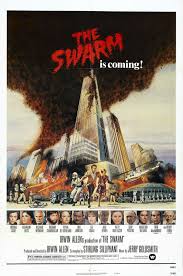When communication with a "U.S. Air Force ICBM bunker" stops, Major Baker (Bradford Dillman) is sent to investigate. When he arrives, he finds that the front doors are open and everyone inside is dead. The only living person is Dr. Brad Crane (Michael Caine). Crane tells Baker that the bunker’s personnel were killed by Africanized bees from Brazil that he has been tracking. Baker notifies his superior, General Slater (Richard Widmark). Slater sends a couple helicopters to check out the area. Both are taken down by the killer bees.
Hiding in the hospital bunker the troops find Captain Dr. Helena Anderson (Katharine Ross). She managed to get six soldiers into the hospital bunker, but they all were stung before they could get to safety. One by one the soldiers get sicker and start to die.
The Durant family is having a picnic in the countryside when they are attacked by the bees. The only survivor is the son, Paul Durant (Christian Juttner). Paul was stung twice and is quite ill from the bee toxins. Upset over the death of his parents, Paul and a couple of his friends find where the bees are swarming and attack them with Molotov cocktails. This sends the bees on a rampage to the nearby town of Marysville. Hundreds of people are killed by the bees.
Crane is given control of the situation. He calls in experts to help figure out how to handle the bees. A multipronged approach seems the best. He contacts fellow scientists, Dr. Hubbard (Richard Chamberlain) who is working on a poison and Dr. Walter Krim (Henry Fonda) whose specialty is trying to find an antidote. Every option they try has no effect on killing the bees. Unless they can come up with a way to control the bees, they will cause catastrophic death and destruction wherever they swarm. In the meantime, the bees are slowly migrating further into the U.S. It is estimated that the swarm will reach Houston, Texas in three days.
“The Swarm” was released in 1978 and was directed by Irwin Allen. It is an American horror disaster movie. The film was based on the 1974 novel by Arthur Herzog. Supposedly, the American Bee Association considered suing the filmmakers for defaming the bees. They did add a disclaimer to the ending credits that read, "The African killer bee portrayed in this film bears absolutely no relationship to the industrious, hardworking American honeybee to which we are indebted for pollinating vital crops that feed our nation."
This is another big production silliness by Irwin Allen, with the usual all-star cast. The movie was really long, over two and a half hours, with lots of characters, of which mostly die, and lots of subplots, which abruptly end. It was a box office flop, and some consider it one of the worst films ever made. I wouldn’t go that far; it was long winded but not horrible. Just a little involved, and a bit slow in spots, but with the usual family friendly Irwin Allen extravaganza.
It is stated that somewhere around 22 million bees were used for the film. The bees were located in various places and moved nightly to both give the bees new flowers to dine on and to prevent "bee rustling", which is an actual term for stealing either bees or their honey. Supposedly the stingers were removed from about 800,000 of the bees, which made them easier to handle. The main problem was little yellow dots that ended up on people’s clothing, which were actually bee feces.


